The Standing Stones of Calanais
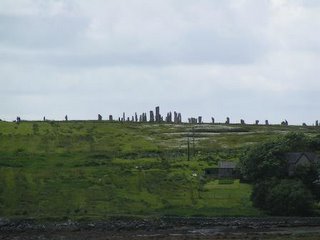
*WARNING*
Before I go on, I ought to inform the reader about my pre-existing relationship and fascination with standing stones. Roughly 6 years ago when I went to
In some cases, such as Stonehenge, the stones were not taken from a convenient location (note my sarcasm on the word convenient) but from obscenely long distances transported by means we can only guess at, so that they could have rocks made of the type they desired (in Stonehenge’s case, blue stone, possibly because blue stone is mildly warm to the touch).
Calanais is the only stone circle to rival the grandeur of
One can fault them for any religious or mystical beliefs or motivations one assumes the creators might have had. However, to create anything able to last a few dozen centuries in weather so harsh, you have to give them points for craftsmanship.
How many people died in the creation of these circles and why? Speculation will probably be the best answer we’ll ever have.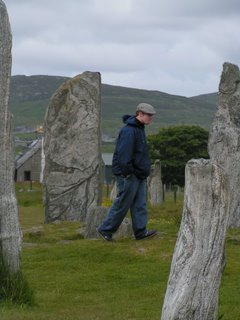
But I rant. Back to Calanais. Calanais rivals
The largest stone there is just off center of the actual circle, and behind it are the remains of a small, now dug up, burial caern. Historians seemed to think that because the stone formation is so very old, its meaning and use has changed dramatically throughout time to the locals. At some point they decided it would be a good place for burials of certain people for whatever reason. Later generations thought this was a terrible violation of the circle and dug the buried up and tossed them away.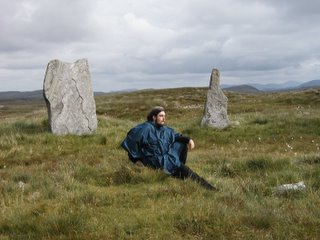
I hesitate to describe my experience. A part of me thinks the awe stirred in me by these rocks is just plain silly. But a much greater part of me perceives the stones with a solemnity and respect reserved for very few things or places in this world. I have no doubt that my family thought I was acting weird.
Callanais was a thousand times less touristy than
I did not actually enter the circle itself for more than half an hour. I walked around, touching each stone, admiring it, feeling I had some obligation to understand each stone at least a little bit before entering the circle. When I say “understanding the stone” I mean that for each and every stone standing there, I cannot estimate how many people must have risked and perhaps found death to ensure the stones transportation and erection.
The first feeling I had when I began this process was to go straight to the largest and most important/interesting looking stones and pass quickly over the stones in seemingly less significant positions. But in a monument such as this, each stone must have be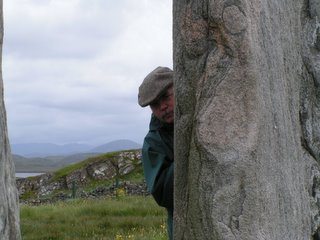 en meticulously picked out, chosen for some reason and purpose (though admittedly the reason might be something along the lines of “here’s a big one”). I wanted to look closely and notice all the details and quirks of each stone.
en meticulously picked out, chosen for some reason and purpose (though admittedly the reason might be something along the lines of “here’s a big one”). I wanted to look closely and notice all the details and quirks of each stone.
Walking from stone to stone studying each stone, touching each stone; somehow it all felt like I was half in a dream.
Some stones in grain and in dimensions seemed to have a certain order and pattern, others complete chaos, colors streaking in every direction. If I tried, I could make out faces in some of their patterns (unintentional, I’m sure). One stones had a pretty distinguished heart shape, enough that I question whether it was crappily carved in at some point.
I was still exploring the outer stones of the group when my family wanted to settle down for our picnic. I told them to go on and eat without me. I was almost done with the outer stones, not having yet stepped foot in the inner circle, when my mother suggested it might be time to get going. Without much good reason I found myself fighting off an angry close to fury at her suggestion. When she added “if you don’t mind” (probably having seen a twitch in my facial expression) I answered pretty calmly that I did mind a little bit, and asked for a few more minutes.
By this time I had my heart set on breaking bread in the circle once I had finished exploring the stones. I hastily explored the stones of the inner circle, and finally the center stone. Honestly, none of them seemed as interesting as the stones of the two parallel lines I had named the “leg stones”, though they were much more massive. Whether purposeful or not, the “leg stones” all seemed to have a sunken in circle somewhere in the midsection of their surfaces, which struck me as the focal point of the stone. This feature was exclusive to the “leg” stones, however, and did not appear in the stones of the main circle.
The small ruined burial cairn in the off-center was just big enough that I might have lied in it if I had wanted to try, and just tall enough to make a perfect bench for lunch. I sat there and broke my bread and ate my cheese. Perhaps a bit slow for my mother’s taste, but it felt a good, if solemn, meal.
I finished.
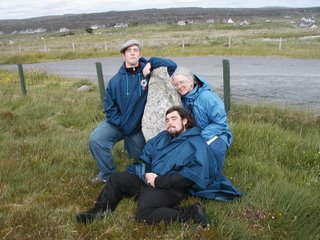

0 Comments:
Post a Comment
<< Home